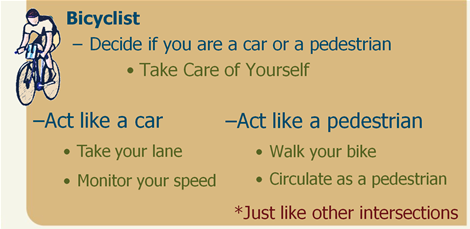Just like other intersections
A cyclist should decide whether to walk or drive around a roundabout. Never cross the center island. Remember what your mother said. Each bullet gets its own paragraph. The initial motivation, reason, and vision to build roundabouts was driven by the safety benefits, high level of operations compared to other intersection forms, and their “more beautiful nature.” In the City’s first application of roundabouts, they were able to preserve trees of significance to the community. A roundabout was the only solution that accomplished this. All change is met with apprehension. Please explore this website to learn more about how you can safely drive on Bend's newest addition: the multilane roundabout. It's just like other intersections! Link to Presentation
Want to know more about Roundabouts? Listen and watch the Presentation: Safety Benefits of Roundabouts
The purpose is to continue the community’s successful use of roundabouts. Using a variety of delivery mechanisms and venues we will disseminate information and educate as many residents and visitors as possible. You can help. We want to reach all users in a variety of ways. Use the roundabout learning kit to show others how to get safely around Bend. Let us know what you think now. Let us know what you think after you have driven the new roundabout. We want to know.
What if . . .
An emergency vehicle with sirens approaches the intersection…
- If acting like a car and on the approach to the intersection, pull to the side
- If acting like a car and in the intersection, travel through the intersection and then pull to the side
- If acting like a pedestrian, clear the crosswalk and remain on the splitter island or sidewalk
- (All of the above behaviors are just like at other intersections)
A bicyclist is acting like a car and approaches the intersection with a truck…
- Slow and allow the truck to take both entry lanes (Just like other intersections)
- Choose your lane based on your destination (Just like other intersections)
- Proceed into the intersection after the truck when there is an acceptable gap (Just like other intersections)
- Remain in your lane and behind the truck in the circulatory roadway (Just like other intersections)
- Signal your exit turn to increase your visibility (Just like other intersections)
Acting like a car and making a left-turn…
- Begin lane change from bike lane to left lane in advance of the roundabout (just like other intersections)
- Consists of…
- Looking for cars
- Using hand signals
- Making use of appropriate gaps
I am a fast and experienced cyclist?
- Act like car
- Be seen
- Take your lane
- Monitor your approach speed
- Acting like a care means that you may need to yield to another vehicle in the roundabout
Cyclist often make the mistake of squeezing into the intersection adjacent to another vehicle entering or circulating…this is NOT appropriate, it creates additional conflicts, and surprises motorists
- You need to be prepared to stop, if necessary
- Pick a safe gap to enter the intersection
- Maintain your lane through the intersection
- Continue to act like a car, and take you lane through the intersection
- Overtaking while in the roundabout is NOT acceptable
Riding adjacent to another vehicle in the roundabout is NOT acceptable
- These maneuvers make cyclist difficult for motorists to see and cyclists more susceptible to being hit
- Monitor your speed as you proceed through the roundabout
- Motorists entering the roundabout need to be able to see you coming and have time to yield
- Riding at speeds faster than other vehicles will make you hard to see
- Signal and take the appropriate exit
- Using hand signals make you more visible to motorists
- Continue to take your exit lane – Be seen
I am a novice?
- Make use of the ramp from the bike lane onto the sidewalk
- Once on the sidewalk, dismount your bike and act like a pedestrian
- Walk your bike to the crosswalk
- pick a safe gap and cross to the splitter island
- Pick another safe gap and cross to the splitter island
- Once on the desired leg
- Remount your bike
- Use the ramp to travel back into the bike lane
The roundabout is full and the cyclist is acting like a car?
- On the approach, change lanes into the appropriate entry lane based on your destination (left to go left, right to go right, through to go through)
- Take your lane, which in this situation may mean take your place in queue with the other motorists
- Once at the yield line, pick a safe gap to enter
- Continue to take your lane in the circulatory roadway
Cyclist often make the mistake of squeezing through intersections adjacent to vehicles; this is NOT appropriate. It creates additional conflicts, makes cyclists difficult to see for motorists, creates a higher speed differential between the cyclists and cars, and increases the potential for bicyclists to get hit.
- Take you exit lane
- Rejoin the bike lane once clear of the intersection
TAKE YOUR LANE on approach and in circulatory roadway


